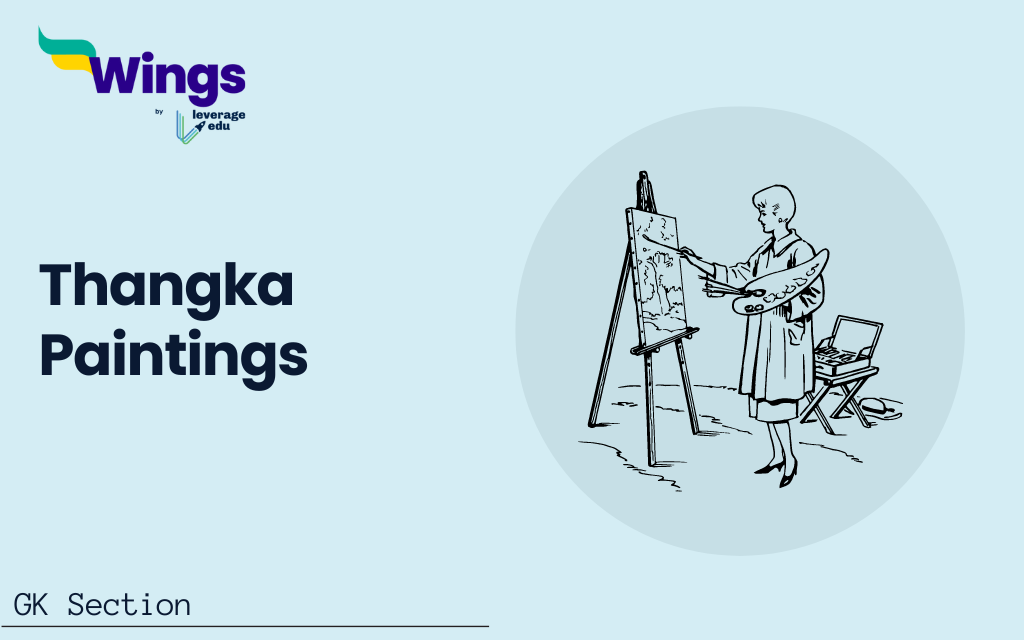A Thangka painting is a Tibetan Buddhist artwork on cotton or silk applique that typically features a Buddhist deity or scenes from mythology. The term “Thangka” can also refer to hangka, tangka, thanka, or tanka.Important teaching aids, thangkas, show the lives of the Buddha, prominent lamas, and other gods and bodhisattvas.Details regarding Thangka paintings will be provided in this article in relation to the Civil Services Examination’s Art and Culture section.
Contents
What are Thangka Paintings?
A thangka is a canvas, silk, or cotton artwork by a Tibetan Buddhist. Although they are often paintings on scrolls, thangkas can also be affixed to a board. Usually, they feature religious themes like mandalas, bodhisattvas, and Buddhas. Thangkas serve in worship, guidance, and meditation.
History of Thangka Painting
- Early Buddhist paintings that may be discovered in a few places in China, like the Mogao Caves and the Ajanta Caves, are the basis for Tibetan Buddhist paintings.
- These cave paintings are examples of early Tibetan paintings on linen. This is where Buddhist wall murals and the thangka art style originated.
- Most of the works by Thangka were commissioned by individuals.
- The people who commissioned these pieces gave them to a monastery, where they would be preserved.
- The oldest surviving thangkas are from the eleventh century. It is thought that at least 20 of them are from the eleventh and twelfth centuries.
- In addition to Mongolia, Tibetan Buddhism was practiced in Ladakh, Sikkim, Arunachal Pradesh, and some regions of Himalayan India. These regions also produced Thangka paintings.
Also Read: Mysore Painting: History, Technique and Motifs
Types of Thangka Paintings
Based on method and material, tangkas fall into the following categories:
- Those appliquéd or embroidered with silk.
- Coloured painting (tson-tang) is the most prevalent and well-known type of Thangka painting.
- Black background (Nagtang)
- Red Background (mar-tang)
- Embroidery (Tsem-thang)
- Gold Background
Features of Thangka Paintings
The following points outline the features of thangka paintings:
- Thangkas are typically small, with a height of 20 to 50 cm.
- Even larger thangkas from the appliqué category are unrolled for particular religious occasions. They will most likely span at least 60 feet.
- Additionally, there are tiny thangkas that were created for temple displays or atlases.
- Tangkas are hand-painted and made of silk or cotton.
- Making cotton that is loosely woven and has widths ranging from 0 to 58 cm is the most widely used technique. Animal glue is used to create a water-soluble medium in which pigments are suspended. Pigments made of minerals and organic materials are used.
The Making of Thangka Painting
The following steps are involved in creating a thangka painting:
- Well, the technique of making a Thangka painting is challenging and requires intense concentration. When creating Buddha paintings, one must take the sutras—which explain the origin and the end of painting creation—into account.
- Several steps are taken into consideration when making Thanga paintings, such as the creation of the canvas, the application of colour, and the finalisation of the image.
- The Thangka paintings are adorned with golden and silver linings, hangings, stitching, and other embellishments.
- Because an artist’s whole body of work could be destroyed by a single stroke, the Thangka artwork was made with meticulous attention to detail.
Also Read: Types of Vedas and Their Significance
The Significance of Thangka Paintings
The significance of thangka paintings are as follows:
- Thangka paintings show the Buddha and his teachings, along with those of other gods and bodhisattvas.
- The most common subject is the Bhavachakra (Wheel of Life), which is the visual representation of the Art of Enlightenment.
- These days, printed versions and poster sizes of the Thangka paintings are widely used for decorating and praying. A lot of paintings were started as a set and then split apart over time.
- Teaching aids in the form of historical depictions of events are found in Thangka paintings.
- Typically, devotional images are used as the centrepiece of a ritual or celebration and as a means for prayer requests. Generally speaking, Thangka paintings are used as a kind of meditation to aid individuals in their quest for enlightenment.
- By visualising himself as the meditation god (yidam) and therefore evoking the qualities of the Buddha within himself, a Buddhist Vajrayana devotee uses a thangka portrait of the god as a guide.
Recent Posts
FAQs
It serves as both the composition’s focal point and primary figure. The eight primary lines consist of the two diagonals, the axes that run vertically and horizontally, and the four outside borders. Buddhists believe that the gods are arranged as follows: Buddhas, Bodhisattvas, Goddesses, Enraged Beings, and Mankind.
It functions as the composition’s main figure as well as its focal point. The two diagonals, the vertical and horizontal axes, and the four outer borders make up the eight fundamental lines. The gods, according to Buddhist belief, are Buddhas, Bodhisattvas, Goddesses, Enraged Beings, and Mankind.
Cotton and silk cloth, cold gold, distemper, gum, cotton thread, metal or wooden frames, paintbrushes, finishing brushes, fabric colours, and enamel paint are the supplies used in Thangka paintings.
This was all about the “Thangka Paintings”. For more such informative blogs, check out our UPSC Exams Section, or you can learn more about us by visiting our Indian exams page.
 One app for all your study abroad needs
One app for all your study abroad needs














